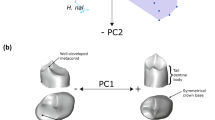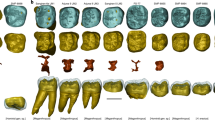Abstract
Shape analyses of cross-sectional mandibular molar morphology, using Euclidean Distance Matrix Analysis, were performed on 79 late Miocene hominoid lower molars from Yuanmou of Yunnan Province, China. These molars were compared to samples of chimpanzee, gorilla, orangutan,Lufengpithecus lufengensis, Sivapithecus, Australopithecus afarensis, and human mandibular molars. Our results indicate that the cross-sectional shape of Yuanmou hominoid lower molars is more similar to the great apes that to humans. There are few differences between the Yuanmou,L. lufengensis, andSivapithecus molars in cross-sectional morphology, demonstrating strong affinities between these three late Miocene hominoids. All three of the fossil samples show strong similarities to orangutans. From this, we conclude that these late Miocene hominoids are more closely related to orangutants than to either the African great apes or humans.
Similar content being viewed by others
References
Andrews, P. 1992. Evolution and environment in the hominoidea.Nature, 360: 641–646.
Andrews, P.;Cronin, J. 1982. The relationship ofSivapithecus andRamapithecus and the evolution of the orang-utan.Nature, 279: 541–546.
Andrews, P.;Pilbeam, D. 1996. The nature of the evidence.Nature, 379: 123–124.
Cole, T. M. III;Richtsmeier, J. T. 1998. A simple method for visualization of influential landmarks when using Euclidean Distance Matrix Analysis.Amer. J. Phys. Anthropol., 107: 273–283.
Groesbeek, B. J. 1996. The serial position of the Trinil upper molars.Anthropol. Sci., 104: 107–130.
He, Z. 1997.Yuanmou Hominoid Fauna. Yunnan Science Press, Kunming.
Hlusko, L. 1999. Shape analysis of Australopithecus molars from Sterkfontein, South Africa.Amer. J. Phys. Anthropol. (Sppl.), 28: 154.
Ho, C. K. 1990. A new Pliocene hominoid skull from Yuanmou, southwest China.Human Evol., 5: 309–318.
Hooijer, D. A. 1948. Prehistoric teeth of man and the orang-utan from Central Sumatra, with notes on the fossil orang-utan from Java and Southern China.Zoöl. Mededelingen, 29: 175–301.
Kelley, J.;Plavcan, J. M. 1998. A simulation test of hominoid species number at Lufeng, China: implications for the use of the coefficient of variation in paleotaxonomy.J. Human Evol., 35: 577–596.
Lele, S. 1991. Some comments on coordinate-free and scale-invariant methods in morphometrics.Amer. J. Phys. Anthropol., 85: 407–417.
Lele, S. 1993. Euclidean distance matrix analysis (EDMA): estimation of mean from and mean from difference.Math. Geol., 25: 573–602.
Lele, S.;Cole III, T. M. 1996. A new test for shape differences when variance-covariance matrices are unequal.J. Human Evol., 31: 193–212.
Lele, S.;Richtsmeier, J. T. 1991. Euclidean Distance Matrix Analysis: a coordinate-free approach for comparing biological shapes using landmark data.Amer. J. Phys. Anthropol., 86: 415–427.
Lele, S.;Richtsmeier, J. T. 1992. On comparing biological shapes: detection of influential landmarks.Amer. J. Phys. Anthropol., 87: 49–65.
Lele, S.;Richtsmeier, J. T. 1995. Euclidean Distance Matrix Analysis: confidence intervals for form and growth differences.Amer. J. Phys. Anthropol., 98: 73–86.
Liu, W.;Zheng, L.;Jiang, C. 2000. The statistical analyses of the metric data of hominoid teenth found in Yuanmou of China.Chinese Sci. Bull., 45: 936–942.
Pilbeam, D. 1996. Genetic and morphological records of the Hominoidea and hominid origins: a synthesis.Mol. Phylogenet. Evol., 5: 155–168.
Qian, F. 1997. Determination of geological age. In:Yuanmou Hominoid Fauna,He,Z. (ed.), Yunnan Science Press, Kunming, pp. 161–181.
Schwartz, J. H. 1990.Lufengpithecus and its potential relationship to an orang-utan clade.J. Human Evol., 19: 591–606.
Schwartz, J. H. 1997.Lufengpithecus and hominoid phylogeny: problems in delineating and evaluating phylogenetically relevant characters. In:Function, Phylogeny, and Fossils,Begun,D. R.;Ward,C. V.;Rose,M. D. (eds.), Plenum Press, New York, pp. 363–388.
Stewart, C. B.;Disotell, T. R. 1998. Primate evolution: in and out of Afirca.Curr. Biol., 8: 582–588.
Ward, S. 1997. The taxonomy and phylogenetic relationships ofSivapithecus revisited. In:Function, Phylogeny, and Fossils,Begun,D. R.;Ward,C. V.;Rose,M. D. (eds.), Plenum Press, New York, pp. 269–290.
Ward, S.;Brown, B. 1986. The facial skeleton ofSivapithecus indicus.Comp. Primate Biol., 1: 413–452.
Ward, S.;Kimbel, W. 1983. Subnasal alveolar morphology and the systematic position ofSivapithecus.Amer. J. Phys. Anthropol., 61: 157–171.
Wu, R. 1987. A revision of the classification of the Lufeng great apes.Acta Anthropol. Sinica, 6: 265–271.
Zhao, L. X. 1998. Incremental markings of enamel and ontogeny ofLufengpithecus lufengensis.Acta Anthropol. Sinica, 18: 102–108.
Zheng, L.;Zhang, X. 1997. Hominoid fossils. In:Yuanmou Hominoid Fauna,He,Z. (ed.), Yunnan Science Press, Kunming, pp. 21–59.
Author information
Authors and Affiliations
About this article
Cite this article
Liu, W., Hlusko, L.J. & Zheng, L. Morphometric analysis of hominoid lower molars from Yuanmou of Yunnan Province, China. Primates 42, 123–134 (2001). https://doi.org/10.1007/BF02558139
Received:
Accepted:
Issue Date:
DOI: https://doi.org/10.1007/BF02558139




